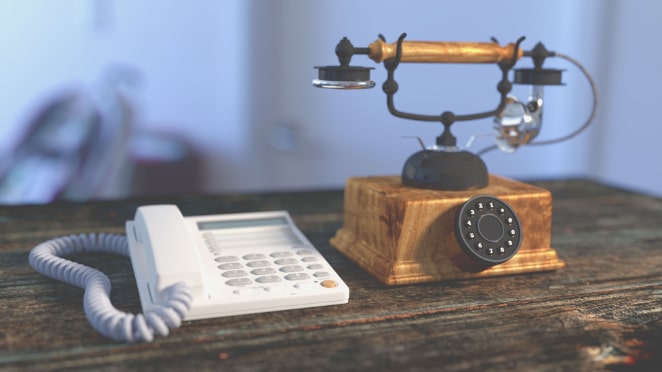
How to Use Email Marketing to Grow Your Design Business
Email lists.
You’ve surely heard about them.
You’ve probably set them up for your clients, and even told them about the importance of collecting emails.
You’re also likely on about a million different ones.
But did you know that an email list can be a great tool for your web design business?

You, yes you, should have an email list, too, if you want to start growing.
The Golden Telephone
Have you ever seen the sketches or heard the stories about the “golden telephone?” Sometimes it’s a red telephone, especially if the story is in a government setting.
Basically, the idea is that there’s somebody who’s important, and there are two ways to reach that somebody: through the secretary (heavily screened), and through the golden telephone. It’s the direct line to the head honcho, and very few people have access to it.
When someone else gives you their email address and joins your list, they’re giving you one of their golden telephones. You now have direct access to them, and this is significant and powerful for your business.

I’m Talking About Email Marketing
When you hear the phrase “email marketing,” a few things might come to mind:
- Beautifully designed newsletters
- A digital marketing strategy
- Coupon codes and special offers
- SPAM
Email marketing can be any and all of those things, and more. When used correctly, ethically, and in a way that’s consistent with your goals and your branding, you’ll come out the other end with more skills, better leads, and a more robust business.

Here’s what I’m talking about:
You’ll Get Better at Copywriting
Headlines are important. You know that. But you’re a web designer, not a copywriter…right?
Well, yes and no.
You’re a web designer, but if you draw the line there and never, ever let yourself grow into other areas closely related to web design, you’re stunting yourself and your business.
Why?
Because the copy is an essential part of the success of your site design. And while you aren’t going to be the one producing it, you might have a thing or two to do with the headlines and taglines in the design.
And one of the absolute very best ways to learn about copywriting is to start sending emails to your list.

You know about headlines and you know about calls to action. The headline on an email is the subject line, and the call to action is typically going to be placed in the body of the email, generally toward the bottom.
With emails, you get pretty much immediate feedback on the strength of your headlines and your CTAs.
For example, if people aren’t opening your emails, your subject lines aren’t working. And if people are reading but not clicking/responding/doing what you want them to do, you’ve got some work to do in the CTA department (not to mention the rest of the message that funnels the reader to the CTA).
Tweaking, experimenting, studying, split-testing…it’s all something you can do in the microcosm of email, and you start to learn pretty fast.
That’s going to come in handy when you start applying your new understanding to your web design. I promise.

Email is Fantastic Lead Gen (For Clients and for Other Income Streams)
The first thing you need to know is the type of leads you want it to generate.
There’s no rule about who your email market should be, whether it’s the niche you’re serving or it’s fellow designers.
In other words, if you want to get more web design clients, your emails should cater to the types of people who will pay for web design services, aka your prospective client.
But if you want to move into offering your own courses, products, or even services (like coaching) to fellow web designers, your emails will be for that crowd, instead.
There’s no right answer…you just need an answer.
And once you’ve built up a solid habit of sending emails (and/or you’ve got a great welcome series in place), you’ll get a great idea of what your market needs and wants.
Let’s Go Over the Very-Very Basics
It’s pretty easy to set up an email list. You may have already done it, even.
I personally like MailChimp because their interface is easy to use, and it’s free up to a pretty generous amount of email addresses. Other options include Aweber, GetResponse, and ConvertKit (which is especially nice if you’ve got a blog but it is a little more expensive).
You’ll want to have an opt-in offer, some sort of free download or incentive for people to join your list. This should, obviously, be tailored to what your target market wants. Maybe it’s an icon set, maybe it’s a workbook, maybe it’s a 5-minute evaluation of their current website.

And you need to have ways for people to sign up for your list embedded on your site. There are plugins and codes you can use to do this. SumoMe is a popular one, and many email providers also have a way to add registration forms to your site. You’re a smart cookie…you can figure that part out pretty easily.
The bigger question is…
What Should you Send in Your Emails?
The bad news is, I can’t answer that question for you. But I can offer some helpful advice!
As a web designer, you might think it’s important to have a beautifully crafted template with custom fonts, stunning, perfectly staged images, and custom iconography.
If that’s what floats your boat, ok, go for it. That stuff can be nicely effective if you’ve got an online shop of sorts and your emails focus on selling things like themes, downloads, icon sets, etc. to fellow designers.
But what really works best is plain, boring ol’ emails…ones that look like a regular, personal email you might send to a real person using a personal email account.
It’s not necessarily plain text, although that can be a good, easy option. I like to have a little bit of HTML because it can give you some insight into who’s opening what and clicking where…but skip the headers, the margins, the whatever.
When you sit down to write, decide what the ONE thing is you want the reader to do when they finish reading your message.
And then you share something, you connect it to your offer, and you give a call to action.
(And then you check your open rates excessively….)
Stuck? There are tons of email marketing strategies and loads of strategic email segment ideas. A quick search and scan will give you some ideas.
But an even better thing you can do is think about the types of emails you like to get – the ones that you open most – and try to emulate the things in those emails that you like.
So tell me: What’s your biggest question about email marketing for your own business? Should we dive deeper into this topic?












